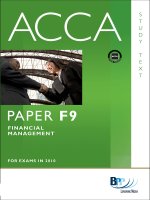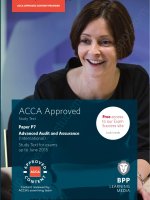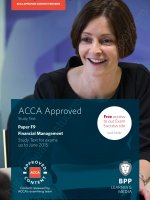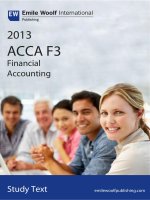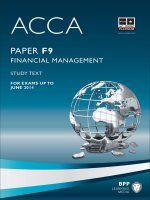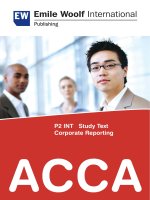ACCA financial reporting F7LSBF study TEXT section 1
Bạn đang xem bản rút gọn của tài liệu. Xem và tải ngay bản đầy đủ của tài liệu tại đây (924.97 KB, 145 trang )
LSB_F7 Financial Reporting_section 1:297mm x 210mm
10/8/09
11:49
Page 1
F7
Paper F7 Financial
Reporting
(International)
ACCA
LSB_F7 Financial Reporting_section 1:297mm x 210mm
10/8/09
11:49
Page 2
FINANCIAL REPORTING (INTERNATIONAL)
British Library Cataloguing-in-Publication Data
A catalogue record for this book is available from the British Library
Published by InterActive World Wide Limited
Westgate House, 8-9 Holborn
London EC1N 2LL
www.iaww.com/publishing
ISBN 978-1-907217-01-2
First Edition 2009
Printed in Romania
NEW ISBN
NUMBER
WANTED
© 2009 InterActive World Wide Limited.
London School of Business & Finance and the LSBF logo are trademarks or registered trademarks of London
School of Business & Finance (UK) Limited in the UK and in other countries and are used under license.
All used brand names or typeface names are trademarks or registered trademarks of their respective holders.
All our rights reserved. No part of this publication may be reproduced, stored in a retrieval system, or
transmitted, in any form or by any means, electronic, mechanical, photocopying, recording or otherwise,
without the prior written permission of InterActive World Wide.
2
LSB_F7 Financial Reporting_section 1:297mm x 210mm
10/8/09
11:49
Page 3
FOREWORD
Foreword
Thank you for choosing to study with the London School of Business and Finance.
A dynamic, quality-oriented and innovative educational institution, the London School of Business and Finance
offers specialised programmes, designed with students and employers in mind. We are always at the frontline,
driving the latest professional developments and trends.
LSBF attracts the highest-quality candidates from over 140 countries worldwide. We work in partnership with
leading accountancy firms, banks and best-practice organisations – enabling thousands of students to realise
their full potential in accountancy, finance and the business world.
With an international perspective, LSBF has developed a rich portfolio of professional qualifications and executive
education programmes. To complement our face-to-face and cutting-edge online learning products, LSBF is
now pleased to offer tailored study materials to support students in their preparation for exams.
The exam-focused content in this manual will provide you with a comprehensive and up-to-date understanding
of the ACCA syllabus. We have an award-winning team of tutors, who are highly experienced in helping students
through their professional exams and have received consistently excellent feedback.
I hope that you will find this manual helpful and wish you the best of luck in your studies.
Aaron Etingen
ACCA, MSI, Founder and CEO
3
LSB_F7 Financial Reporting_section 1:297mm x 210mm
FINANCIAL REPORTING (INTERNATIONAL)
4
10/8/09
11:49
Page 4
LSB_F7 Financial Reporting_section 1:297mm x 210mm
10/8/09
11:49
Page 5
CONTENTS
Contents
Foreword
3
About ACCA Paper F7
7
Contents
Syllabus and Study Guide
5
11
Pilot Paper
27
Chapter 1 - The Consolidated Statement of Financial Position
51
Examinable Documents
Chapter 2 - The Consolidated Income Statement
47
85
Chapter 3 - Associates
107
Chapter 5 - Tangible Non-current Assests
145
Chapter 7 - Impairment of Assets
179
Chapter 9 - Inventory and Construction
209
Chapter 11 - Tax and Deferred Tax
239
Chapter 4 - Published Accounts - an Introduction
Chapter 6 - Intangible Assets
Chapter 8 - Leasing
Chapter 10 - Reporting Financial Performance
Chapter 12 - Provisions and Contingencies
129
165
193
227
253
Chapter 13 - Substance over Form
271
Chapter 15 - Financial Instruments
305
Chapter 14 - Conceptual and Regulatory
287
Chapter 16 - Earnings per Share
323
Chapter 18 - Statements of Cash Flows
363
Chapter 17 - Analysis and Interpretation
Chapter 19 - Alternative Models and Practices
Feedback and Review Form
339
385
395
5
LSB_F7 Financial Reporting_section 1:297mm x 210mm
FINANCIAL REPORTING (INTERNATIONAL)
6
10/8/09
11:49
Page 6
LSB_F7 Financial Reporting_section 1:297mm x 210mm
10/8/09
11:49
Page 7
F7
About ACCA
Paper F7 Financial
Reporting
(International)
LSB_F7 Financial Reporting_section 1:297mm x 210mm
FINANCIAL REPORTING (INTERNATIONAL)
8
10/8/09
11:50
Page 8
LSB_F7 Financial Reporting_section 1:297mm x 210mm
10/8/09
11:50
Page 9
ABOUT ACCA PAPER F7 - FINANCIAL REPORTING (INTERNATIONAL)
Aim of the Paper
The aim of the paper is to introduce knowledge and understanding of management accounting.The paper develops
knowledge and understanding of how to prepare and calculate costing information for use within a business.
Outline of the Syllabus
Explain the nature of cost and management accounting
Explain the purpose of cost and management accounting
Identify and describe costs by classification, behaviour and purpose
Explain and apply cost accounting techniques
Prepare and coordinate budgets for feedback and control
Use management accounting techniques to make and support decision making
Format of the Exam Paper
The syllabus is assessed by a two hour computer-based examination.
The examination consists of a mixture of 2 mark and 1 mark questions.
There will be 40 compulsory 2 mark questions
There will be 10 compulsory 1 mark questions
NEW COPY
WANTED
Getting the most from your studies
Manage your time effectively. If you have a busy work schedule use your study planner to catch up. Do not
allow yourself to fall behind.
Make sure that you can apply all the numbers to the formulae and can perform the calculations accurately
Practice as many questions as you can. You should aim to have attempted every question in the revision kit at
least twice before the exam.
9
LSB_F7 Financial Reporting_section 1:297mm x 210mm
FINANCIAL REPORTING (INTERNATIONAL)
10
10/8/09
11:50
Page 10
LSB_F7 Financial Reporting_section 1:297mm x 210mm
10/8/09
11:50
Page 11
F7
Syllabus and
Study Guide
LSB_F7 Financial Reporting_section 1:297mm x 210mm
FINANCIAL REPORTING (INTERNATIONAL)
12
10/8/09
11:50
Page 12
LSB_F7 Financial Reporting_section 1:297mm x 210mm
10/8/09
11:50
Page 13
SYLLABUS AND STUDY GUIDE
Financial Reporting (INT)
This syllabus and study guide is designed to help with planning study and to provide detailed information on
what could be assessed in any examination session.
The Structure of the Syllabus and Study Guide
RELATIONAL DIAGRAM OF PAPER WITH OTHER PAPERS
This diagram shows direct and indirect links between this paper and other papers preceding or between this
paper and other papers underpinned by other papers such as Advanced Performance Management by Performance
Management. These links are shown as solid line arrows. Other papers only have indirect relationships with
each other such as links existing between the accounting and auditing papers. The links between these are
shown as dotted line arrows. This diagram indicates where you are expected to have underpinning knowledge
and where it would be useful to review previous learning before undertaking study.
OVERALL AIM OF THE SYLLABUS
This explains briefly the overall objective of the paper and indicates in the broadest sense the capabilities to be
developed within the paper.
MAIN CAPABILITIES
This paper’s aim is broken down into several main capabilities which divide the syllabus and study guide into
discrete sections.
RELATIONAL DIAGRAM OF THE MAIN CAPABILITIES
This diagram illustrates the flows and links between the main capabilities (sections) of the syllabus and should
be used as an aid to planning teaching and learning in a structured way.
SYLLABUS RATIONALE
This is a narrative explaining how the syllabus is structured and how the main capabilities are linked. The rationale
also explains in further detail what the examination intends to assess and why.
DETAILED SYLLABUS
This shows the breakdown of the main capabilities (sections) of the syllabus into subject areas. This is the
blueprint for the detailed study guide.
APPROACH TO EXAMINING THE SYLLABUS
This section briefly explains the structure of the examination and how it is assessed.
STUDY GUIDE
This is the main document that students, tuition providers and publishers should use as the basis of their studies,
instruction and materials. Examinations will be based on the detail of the study guide which comprehensively
identifies what could be assessed in any examination session. The study guide is a precise reflection and breakdown
of the syllabus. It is divided into sections based on the main capabilities identified in the syllabus. These sections
are divided into subject areas which relate to the sub-capabilities included in the detailed syllabus. Subject areas
are broken into sub-headings which describe the detailed outcomes that could be assessed in examinations.
These outcomes are described using verbs indicating what exams may require students to demonstrate, and
the broad intellectual level at which these may need to be demonstrated (*see intellectual levels below).
13
LSB_F7 Financial Reporting_section 1:297mm x 210mm
10/8/09
11:50
Page 14
FINANCIAL REPORTING (INTERNATIONAL)
READING LISTS
ACCA has two official publishers: BPP Learning Media and Kaplan Publishing. Both these publishers base their
study texts on the detailed contents of the study guides as published by ACCA. ACCA takes no editorial
responsibility for the detailed content of these study texts although ACCA examiners will annually review their
content for general appropriateness and relevance in supporting effective study towards ACCA examinations.
In addition ACCA examiners will recommend other text books where appropriate, which students may read in
order to widen their reading beyond the approved study texts. Relevant articles will also be published in student
accountant.
Intellectual Levels
The syllabus is designed to progressively broaden and deepen the knowledge, skills and professional values
demonstrated by the student on their way through the qualification.
The specific capabilities within detailed syllabuses and study guides are assessed at one of three intellectual or
cognitive levels:
Level 1: Knowledge and comprehension
Level 2: Application and analysis
Level 3: Synthesis and evaluation
Very broadly, these intellectual levels relate to the three cognitive levels at which the Knowledge module, the
Skills module and the Professional level are assessed.
Each subject area in the detailed study guide included in this document is given a 1, 2, or 3 superscript, denoting
intellectual level, marked at the end of each relevant line. This gives an indication of the intellectual depth at
which an area could be assessed within the examination. However, while level 1 broadly equates with the
Knowledge module, level 2 equates to the Skills module and level 3 to the Professional level, some lower level
skills can continue to be assessed as the student progresses through each module and level. This reflects that
at each stage of study there will be a requirement to broaden, as well as deepen capabilities. It is also possible
that occasionally some higher level capabilities may be assessed at lower levels.
Learning Hours
The ACCA qualification does not prescribe or recommend any particular number of learning hours for
examinations because study and learning patterns and styles vary greatly between people and organisations.
This also recognises the wide diversity of personal, professional and educational circumstances in which ACCA
students find themselves.
Each syllabus contains between 23 and 35 main subject area headings depending on the nature of the subject
and how these areas have been broken down.
Guide to Exam Structure
The structure of examination varies within and between modules and levels.
The Fundamentals level examinations contain 100% compulsory questions to encourage candidates to study
across the breadth of each syllabus.
The Knowledge module is assessed by equivalent two-hour paper based and computer based examinations.
The Skills module examinations are all paper based three-hour papers. The structure of papers varies from ten
questions in the Corporate and Business Law (F4) paper to four 25 mark questions in Financial Management (F9).
Individual questions within all Skills module papers will attract between 10 and 30 marks.
The Professional level papers are all three-hour paper based examinations, all containing two sections. Section A
is compulsory, but there will be some choice offered in Section B.
14
LSB_F7 Financial Reporting_section 1:297mm x 210mm
10/8/09
11:50
Page 15
SYLLABUS AND STUDY GUIDE
For all three hour examination papers,ACCA has introduced 15 minutes reading and planning time.
This additional time is allowed at the beginning of each three-hour examination to allow candidates to read the
questions and to begin planning their answers before they start writing in their answer books. This time should
be used to ensure that all the information and exam requirements are properly read and understood.
During reading and planning time candidates may only annotate their question paper. They may not write anything
in their answer booklets until told to do so by the invigilator.
The Essentials module papers all have a Section A containing a major case study question with all requirements
totalling 50 marks relating to this case. Section B gives students a choice of two from three 25 mark questions.
Section A of each of the Options papers contains 50-70 compulsory marks from two questions, each attracting
between 25 and 40 marks. Section B will offer a choice of two from three questions totalling 30-50 marks with
each question attracting between 15 and 25 marks.
The pass mark for all ACCA Qualification examination papers is 50%.
Guide to Examination Assessment
ACCA reserves the right to examine anything contained within the study guide at any examination session.
This includes knowledge, techniques, principles, theories, and concepts as specified.
For the financial accounting, audit and assurance, law and tax papers except where indicated otherwise,ACCA
will publish examinable documents once a year to indicate exactly what regulations and legislation could potentially
be assessed within identified examination sessions.
For paper based examinations regulation issued or legislation passed on or before 30th September annually,
will be assessed from June 1st of the following year to May 31st of the year after. Therefore, paper based
examinations in June 2009, December 2009 (and March 2010 where applicable) will be assessed on regulations
issued and legislation passed on or before 30 September 2008.
Regulation issued or legislation passed in accordance with the above dates may be examinable even if the
effective date is in the future.
The term issued or passed relates to when regulation or legislation has been formally approved.
The term effective relates to when regulation or legislation must be applied to an entity transactions and business
practices.
The study guide offers more detailed guidance on the depth and level at which the examinable documents will
be examined.The study guide should therefore be read in conjunction with the examinable documents list.
Relational Diagram of Paper with Other Papers
CL (F4)
CR (P2)
BA (P3)
FR (F7)
AA (F8)
FA (F3)
15
LSB_F7 Financial Reporting_section 1:297mm x 210mm
10/8/09
11:50
Page 16
FINANCIAL REPORTING (INTERNATIONAL)
Aim
To develop knowledge and skills in understanding and applying accounting standards and the theoretical framework
in the preparation of financial statements of entities, including groups and how to analyse and interpret those
financial statements.
Main Capabilities
On successful completion of this paper, candidates should be able to:
A
B
C
D
E
Discuss and apply a conceptual framework for financial reporting
Discuss a regulatory framework for financial reporting
Prepare and present financial statements which confirm with International accounting standards
Account for business combinations in accordance with International accounting standards
Analyse and interpret financial statements.
Relational Diagram of Main Capabilities
A conceptual framework
for financial reporting
(A)
A regulatory framework
for financial reporting
(B)
Financial statements (C)
Business combinations (D)
Analysing and
interpreting
financial
statements
(E)
Rationale
The financial reporting syllabus assumes knowledge acquired in Paper F3, Financial Accounting, and develops
and applies this further and in greater depth.
The syllabus begins with the conceptual framework of accounting with reference to the qualitative characteristics
of useful information and the fundamental bases of accounting introduced in the Paper F3 syllabus with the
Knowledge module. It then moved into a detailed examination of the regulatory framework of accounting and
how this informs the standard setting process.
The main areas of the syllabus cover the reporting of financial information for single companies and for groups
in accordance with generally accepted accounting principles and relevant accounting standards.
Finally, the syllabus covers the analysis and interpretation of information from financial reports.
16
LSB_F7 Financial Reporting_section 1:297mm x 210mm
10/8/09
11:50
Page 17
SYLLABUS AND STUDY GUIDE
Detailed Syllabus
A
B
C
D
E
A CONCEPTUAL FRAMEWORK FOR FINANCIAL REPORTING
1.
2.
3.
4.
5.
6.
The need for a conceptual framework
Understandability, relevance, reliability and comparability
Recognition and measurement
The legal versus the commercial view of accounting
Alternative models and practices
The concept of ‘faithful representation’ (‘true and fair view’)
A REGULATORY FRAMEWORK FOR FINANCIAL REPORTING
1. Reasons for the existence of a regulatory framework
2. The standard setting process
3. Specialised, not-for-profit, and public sector entities
FINANCIAL STATEMENTS
1. Statements of cash flows
2. Tangible non-current assets
3. Intangible assets
4. Inventory
5. Financial assets and financial liabilities
6. Leases
7. Provisions, contingent liabilities, and contingent assets
8. Impairment of assets
9. Taxation
10. Regulatory requirements relating to the preparation of financial statements
11. Reporting financial performance
BUSINESS COMBINATIONS
1. The concept and principles of a group
2. The concept of consolidated financial statements
3. Preparation of consolidated financial statements including an associate
ANALYSING AND INTERPRETING FINANCIAL STATEMENTS
1.
2.
3.
4.
Limitations of financial statements
Calculation and interpretation of accounting ratios and trends to address users’ and stakeholders’ needs
Limitations of interpretation techniques
Specialised, not-for-profit, and public sector entities
Approach to examining the Syllabus
The syllabus is assessed by a three-hour paper-based examination.
All questions are compulsory. It will contain both computational and discursive elements.
Some questions will adopt a scenario/case study approach.
Question 1 will be a 25 mark question on the preparation of group financial statements and/or extracts
thereof, and may include a small discussion element. Computations will be designed to test and understanding
of principles.
Question 2, for 25 marks, will test the reporting of non-group financial statements. This may be from information
in a trial balance or by restating draft financial statements.
17
LSB_F7 Financial Reporting_section 1:297mm x 210mm
10/8/09
11:50
Page 18
FINANCIAL REPORTING (INTERNATIONAL)
Question 3, for 25 marks, is likely to be an appraisal of an entity’s performance and may involve statements of
cash flows.
Questions 4 and 5 will cover the remainder of the syllabus and will be worth 15 and 10 marks respectively.
An individual question may often involve elements that relate to different subject areas of the syllabus. For
example the preparation of an entity’s financial statements could include matters relating to several accounting
standards.
Questions may ask candidates to comment on the appropriateness or acceptability of management’s opinion or
chosen accounting treatment. An understanding of accounting principles and concepts and how these are applied
to practical examples will be tested.
Questions on topic areas that are also included in Paper F3 will be examined at an appropriately greater depth
in this paper.
Candidates will be expected to have an appreciation of the need for specified accounting standards and why
they have been issued. For detailed or complex standards, candidates need to be aware of their principles and
key elements.
18
LSB_F7 Financial Reporting_section 1:297mm x 210mm
10/8/09
11:50
Page 19
SYLLABUS AND STUDY GUIDE
STUDY GUIDE
A
A Conceptual Framework for Financial Reporting
1.
THE NEED FOR A CONCEPTUAL FRAMEWORK
b)
discuss whether a conceptual framework is necessary and what an alternative system might be.[2]
a)
describe what is meant by a conceptual framework of accounting;[2]
2.
UNDERSTANDABILITY, RELEVANCE, RELIABILITY AND COMPARABILITY
b)
discuss what is meant by relevance and reliability and describe the qualities that enhance these characteristics;[2]
d)
distinguish between changes in accounting policies and changes in accounting estimates and describe how
accounting standards apply the principle of comparability where an entity changes its accounting policies; [2]
a)
c)
e)
discuss what is meant by understandability in relation to the provision of financial information;[2]
discuss the importance of comparability to users of financial statements;[2]
recognise and account for changes in accounting policies and the correction of prior period errors.[2]
3.
RECOGNITION AND MEASUREMENT
b)
apply the recognition criteria to: [2]
a)
c)
d)
e)
define what is meant by ‘recognition’ in financial statements and discuss the recognition criteria;[2]
i) assets and liabilities
ii) income and expenses.
discuss revenue recognition issues; indicate when income and expense recognition should occur;[2]
demonstrate the role of the principle of substance over form in relation to recognising sales revenue.;[2]
explain the following measures and compute amounts using: [2]
i) historical cost
ii) fair value/current cost
iii) net realisable value
iv) present value of future cash flows.
4.
a)
b)
c)
d)
THE LEGAL VERSUS THE COMMERCIAL VIEW OF ACCOUNTING
explain the importance of recording the commercial substance rather than the legal form of transactions – give
examples where recording the legal form of transactions may be misleading;[2]
describe the features which may indicate that the substance of transactions differs from their legal form;[2]
apply the principle of substance over form to the recognition and derecognition of assets and liabilities;[2]
recognise the substance of transactions in general, and specifically account for the following types of
transaction:[2]
i) goods sold on sale or return/consignment inventory
ii) sale and repurchase/leaseback agreements
iii) factoring of receivables.
19
LSB_F7 Financial Reporting_section 1:297mm x 210mm
10/8/09
11:50
Page 20
FINANCIAL REPORTING (INTERNATIONAL)
5.
ALTERNATIVE MODELS AND PRACTICES
b)
discuss whether the use of current value accounting overcomes the problems of historical cost accounting;[2]
a)
c)
describe the concept of financial and physical capital maintenance and how this affects the determination of
profits.[1]
6.
THE CONCEPT OF ‘FAITHFUL REPRESENTATION’ (‘TRUE AND FAIR VIEW’)
a)
describe what is meant by financial statements achieving a faithful representation; [2]
b)
discuss whether faithful representation constitutes more than compliance with accounting standards; [1]
B
A Regulatory Framework for Financial Reporting
1.
REASONS FOR EXISTENCE OF A REGULATORY FRAMEWORK
b)
explain why accounting standards on their own are not a complete regulatory framework;[2]
c)
a)
c)
2.
a)
b)
c)
3.
a)
indicate the circumstances and required disclosures where a ‘true and fair’ override may apply. [1]
explain why a regulatory framework is needed; [2]
distinguish between a principles based framework and discuss whether they can be complementary. [1]
THE STANDARD SETTING PROCESS
describe the structure and objectives of the IASC Foundation, the International Accounting Standards Board
(IASB), the Standards Advisory Council (SAC) and the International Financial Reporting Interpretations
Committee (IFRIC); [2]
describe the IASB’s Standard setting process including revisions to and interpretations of Standards; [2]
explain the relation ship of national standard setters to the IASB in respect of the standard setting process. [2]
SPECIALISED, NOT-FOR-PROFIT AND PUBLIC SECTOR ENTITIES
distinguish between the primary aims of not-for profit and public sector entities and those of profit oriented
entities;[1]
b)
discuss the extent to which International Financial Reporting Standards (IFRSs) are relevant to specialised,
not-for-profit and public sector entities.[1]
C
Financial Statements
1.
STATEMENTS OF CASH FLOWS
a)
b)
c)
20
describe the advantages and disadvantages of the use of historical cost accounting;[2]
prepare a statement of cash flows for a single entity (not a group) in accordance with relevant accounting
standards using the direct and the indirect method;[2]
compare the usefulness of cash flow information with that of an income statement or statement of comprehensive
income;[2]
interpret a statement of cash flows (together with other financial information) to assess the performance and
financial position entity.[2]
LSB_F7 Financial Reporting_section 1:297mm x 210mm
10/8/09
11:50
Page 21
SYLLABUS AND STUDY GUIDE
2.
TANGIBLE NON-CURRENT ASSETS
b)
identify subsequent expenditure that may be capitalised (including borrowing costs), distinguishing between
capital and revenue items.;[2]
a)
c)
d)
e)
f)
g)
h)
define and compute the initial measurement of a non-current (including a self-constructed) asset;[2]
discuss the requirements of relevant accounting standards in relation to the revaluation of no-current assets; [2]
account for revaluation and disposal gains and losses for non-current assets;[2]
compute depreciation based on the cost and revaluation models and on assets that have two or more significant
parts (complex assets); [2]
apply the provisions of relevant accounting standards in relation to accounting for government grants;[2]
discuss why the treatment of investment properties should differ from other properties;[2]
apply the requirements of relevant accounting standards for investment property. [2]
3.
INTANGIBLE ASSETS
b)
distinguish between goodwill and other intangible assets;
a)
c)
d)
e)
discuss the nature and accounting treatment of internally generated and purchased intangibles;[2]
describe the criteria for the initial recognition and measurement of intangible assets;[2]
describe the subsequent accounting treatment, including the principle of impairment tests in relation to goodwill;
indicate why the value of purchase consideration for an investment may be less than the value of the acquired
identifiable net assets and how the difference should be accounted for;[2]
f)
describe and apply the requirements of relevant accounting standards to research and development
expenditure.[2]
4.
INVENTORY
b)
define a construction contract and discuss the role of accounting concepts in the recognition of profit; [2]
a)
describe and apply the principle of inventory valuation;[2]
c)
describe the acceptable methods of determining the stage (percentage) of completion of a contract;[2]
5.
FINANCIAL ASSETS AND FINANCIAL LIABILITIES
b)
define financial instruments in terms of financial assets and financial liabilities;[1]
d)
a)
c)
prepare financial statement extracts for construction contracts. [2]
explain the need for an accounting standard on financial instruments;[1]
indicate for the following categories of financial instruments how they should be measured and how any gains
and losses from subsequent measurement should be treated in the financial statements: [1]
i) fair value through profit and loss
ii) held to maturity (use of amortised cost, interest to income)
iii) available for sale (carried at fair value with changes to equity, but dividends to income)
d)
e)
iv) loans and receivables.
distinguish between debt and equity capital;[2]
apply the requirements of relevant accounting standards to the issue and finance costs of:[2]
i) equity
ii) redeemable preference shares and debt instruments with no conversion rights (principle of amortised cost)
iii) convertible debt.
21
LSB_F7 Financial Reporting_section 1:297mm x 210mm
10/8/09
11:50
Page 22
FINANCIAL REPORTING (INTERNATIONAL)
6.
a)
b)
c)
LEASES
explain why recording the legal form of a finance lease can be misleading to users (referring to the commercial
substance of such leases);[2]
describe and apply the method of determining a lease type (i.e. an operating or finance lease);[2]
discuss the effect on the financial statements of a finance lease being incorrectly treated as an operating lease;[2]
d)
account for assets financed by finance leases in the records of the lessee;[2]
7.
PROVISIONS, CONTINGENT LIABILITIES AND CONTINGENT ASSETS
b)
distinguish between legal and constructive obligations;[2]
e)
a)
c)
account for operating leases in the records of the lessee.[2]
explain why an accounting standard on provisions is necessary;[2]
state when provisions may or may not be made and demonstrate how they should be accounted for;[2]
d)
explain how provisions should be measured;[1]
f)
identify and account for: [2]
e)
define contingent assets and liabilities and describe their accounting treatment;[2]
i) warranties/guarantees
ii) onerous contracts
iii) environmental and similar provisions
iv) provisions for future repairs or refurbishments.
8.
IMPAIRMENT OF ASSETS
b)
identify the circumstances that may indicate impairments to assets;[2]
a)
c)
describe what is meant by a cash generating unit;[2]
d)
state the basis on which impairment losses should be allocated, and allocate an impairment loss to the assets of
a cash generating unit. [2]
9.
TAXATION
b)
record entries relating to income tax in the accounting records;[2]
a)
account for current taxation in accordance with relevant accounting standards; [2]
c)
explain the effect of taxable temporary differences on accounting and taxable profits;[2]
10.
REGULATORY REQUIREMENTS RELATING TO THE PREPARATION OF FINANCIAL STATEMENTS
d)
a)
b)
22
define an impairment loss;[2]
compute and record deferred tax amounts in the financial statements.[2]
describe the structure (format) and content of financial statements presented under IFRS;[2]
prepare an entity’s financial statements in accordance with the prescribed structure and content. [2]
LSB_F7 Financial Reporting_section 1:297mm x 210mm
10/8/09
11:50
Page 23
SYLLABUS AND STUDY GUIDE
11.
REPORTING FINANCIAL PERFORMANCE
b)
define and account for non-current assets held for sale and discontinued operations; [2]
a)
discuss the importance of identifying and reporting the results of discontinued operations; [2]
c)
indicate the circumstances where separate disclosure of material items of income and expense is required;[2]
e)
describe and prepare a statement of changes in equity;[2]
d)
f)
prepare and explain the contents and purpose of the statement of changes in equity;[2]
earnings per share (eps)
i) calculate the eps in accordance with relevant accounting standards (dealing with bonus issues, full market
value issues and rights issues) [2]
ii) explain the relevance of the diluted eps and calculate the diluted eps involving convertible debt and share
options (warrants) [2]
iii) explain why the trend of eps may be a more accurate indicator of performance than a company’s profit
trend and the importance of eps as a stock market indicator [2]
iv) discuss the limitations of using eps as a performance measure.[3]
D
Business Combinations
1.
THE CONCEPT AND PRINCIPLES OF A GROUP
b)
explain and apply the definition of a subsidiary within relevant accounting standards;[2]
a)
describe the concept of a group as a single economic unit;[2]
c)
describe why directors may not wish to consolidate a subsidiary and the circumstances where this is permitted;[2]
e)
explain why it is necessary to eliminate intra-group transactions.[2]
d)
explain the need for using coterminous year ends and uniform accounting policies when preparing consolidated
financial statements;[2]
2.
THE CONCEPT OF CONSOLIDATED FINANCIAL STATEMENTS
b)
indicate the effect that the related party relationship between a parent and subsidiary may have on the subsidiary’s
entity statements and the consolidated financial statements;[2]
a)
c)
d)
explain the objective of consolidated financial statements;[2]
explain why it is necessary to use fair values for the consideration for an investment in a subsidiary together
with the fair values of a subsidiary’s identifiable assets and liabilities when preparing consolidated financial
statements;[2]
describe and apply the required accounting treatment of consolidated goodwill. [2]
23
LSB_F7 Financial Reporting_section 1:297mm x 210mm
10/8/09
11:50
Page 24
FINANCIAL REPORTING (INTERNATIONAL)
3.
a)
b)
c)
d)
e)
PREPARATION OF CONSOLIDATED FINANCIAL STATEMENTS INCLUDING AN ASSOCIATE
prepare a consolidated statement of financial position for a simple group (parent and one subsidiary) dealing
with pre and post acquisition profits, minority interests and consolidated goodwill;[2]
prepare a consolidated income statement and consolidated statement of comprehensive income for a simple
group dealing with an acquisition in the period and minority interest; [2]
explain and account for other reserves (e.g. share premium and revaluation reserves);[1]
account for the effects in the financial statements of intra-group trading;[2]
account for the effects of fair value adjustments (including their effect on consolidated goodwill) to: [2]
i) depreciating and non-depreciating non-current assets
ii) inventory
iii) monetary liabilities
iv) assets and liabilities not included in the subsidiary’s own statement of financial position, including contingent
assets and liabilities.
f)
account for goodwill impairment;[2]
h)
prepare consolidated financial statements to include a single subsidiary and an associate.[2]
g)
define an associate and explain the principles and reasoning for the use of equity accounting;[2]
E
Analysing and Interpreting Financial Statements
1.
LIMITATIONS OF FINANCIAL STATEMENTS
b)
discuss how financial statements may be manipulated to produce a desired effect (creative accounting, window
dressing);[2]
a)
c)
d)
indicate the problems o f using historic information to predict future performance and trends;[2]
recognise how related party relationships have the potential to mislead users;[2]
explain why figures in a statement of financial position may not be representative of average valued throughout
the period for example, due to: [2]
i) seasonal trading
ii) major asset acquisitions near the end of the accounting period.
2
a)
b)
c)
CALCULATION AND INTERPRETATION OF ACCOUNTING RATIOS AND TRENDS TO ADDRESS USERS’
AND STAKEHOLDERS’ NEEDS
define and compute relevant financial ratios;[2]
explain what aspects of performance specific ratios are intended to assess;[2]
analyse and interpret ratios to give an assessment of an entity’s performance and financial position in comparison
with: [2]
i) an entity’s previous period’s financial statements
ii) another similar entity for the same reporting period
d)
e)
24
iii) industry average ratios.
interpret an entity’s financial statements to give advice from the perspectives of different stakeholders;[2]
discuss how the interpretation of current value based financial statements would differ from those using historical
cost based accounts.[1]
LSB_F7 Financial Reporting_section 1:297mm x 210mm
10/8/09
11:50
Page 25
SYLLABUS AND STUDY GUIDE
3.
LIMITATIONS OF INTERPRETATION TECHNIQUES
b)
discuss the effect that changes in accounting policies or the use of different accounting polices between entities
can have on the ability to interpret performance;[2]
a)
c)
discuss the limitations in the use of ratio analysis for assessing corporate performance;[2]
indicate other information, including non-financial information, that may be of relevance to the assessment of an
entity’s performance. [1]
4.
SPECIALISED, NOT-FOR-PROFIT AND PUBLIC SECTOR ENTITIES
a)
discuss the different approaches that may be required when assessing the performance of specialised,
not-for-profit and public sector organisations.[1]
25
